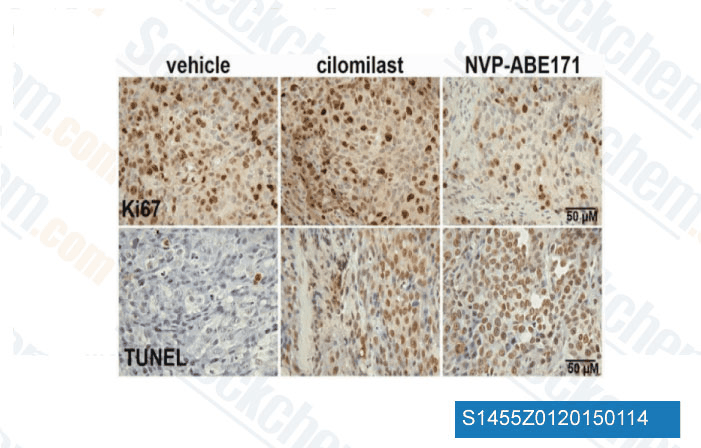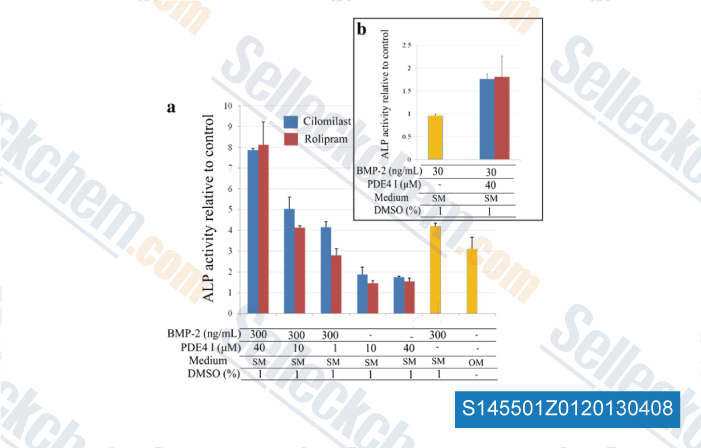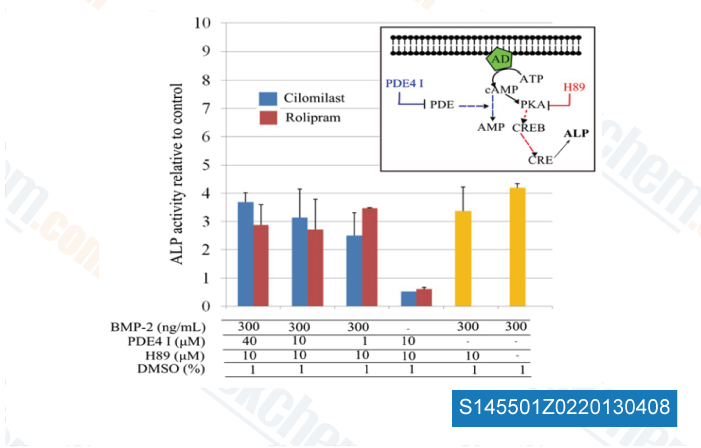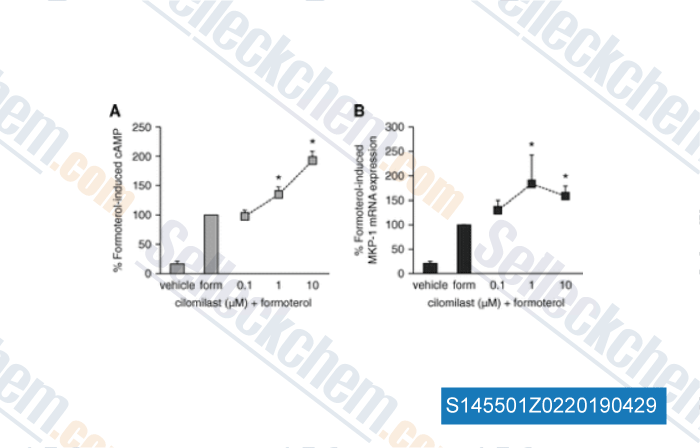|
Toll Free: (877) 796-6397 -- USA and Canada only -- |
Fax: +1-832-582-8590 Orders: +1-832-582-8158 |
Tech Support: +1-832-582-8158 Ext:3 Please provide your Order Number in the email. |
Technical Data
| Formula | C20H25NO4 |
||||||||||||||
| Molecular Weight | 343.42 | CAS No. | 153259-65-5 | ||||||||||||
| Solubility (25°C)* | In vitro | DMSO | 69 mg/mL (200.92 mM) | ||||||||||||
| Ethanol | 50 mg/mL (145.59 mM) | ||||||||||||||
| Water | Insoluble | ||||||||||||||
| In vivo (Add solvents to the product individually and in order) |
|
||||||||||||||
|
* <1 mg/ml means slightly soluble or insoluble. * Please note that Selleck tests the solubility of all compounds in-house, and the actual solubility may differ slightly from published values. This is normal and is due to slight batch-to-batch variations. * Room temperature shipping (Stability testing shows this product can be shipped without any cooling measures.) |
|||||||||||||||
Preparing Stock Solutions
Biological Activity
| Description | Cilomomilast (SB-207499) is a potent PDE4 inhibitor with IC50 of about 110 nM, has anti-inflammatory activity and low central nervous system activity. Phase 3. | ||||
|---|---|---|---|---|---|
| Targets |
|
||||
| In vitro | Cilomilast produces a concentration-dependent increase in cAMP content in U937 cells. This compound produces a concentration-dependent increase in cAMP content in U937 cells. [2] In isolated human monocytes, it and (R)-rolipram are equipotent at suppressing LPS-induced TNF-α formation with -log (IC50) of 7.0 and 7.2, respectively. Both this compound and (R)-rolipram produces a modest prevention of fMLP-induced degranulation of human neutrophils. It and (R)-rolipram are equipotent at suppressing neutrophil activation with -log (IC50) of 7.1 and 6.4, respectively. [2] This chemical significantly decreases the expression of TNF-α in the cornea and IL-1α, IL-1β, and TNF-α in the conjunctivaas compared to vehicle control. Its treatment markedly decreases the presence of CD11b+ antigen-presenting cells in the central and peripheral cornea, and leads to decreased conjunctival expression of cytokines IL-6, IL-23, and IL-17. Moreover, it decreases the expression of IL-17 and IL-23 in the draining lymph nodes. [3] It reduces TLR4 expression, IL-8 release and neutrophil chemotactic activity as well as it increased IP-10 release and lymphocyte chemotactic activity. [4] | ||||
| In vivo | Cilomilast inhibits human TNFα production with oral ED50 of 4.9 mg/kg. In contrast to their equipotent activity against TNFα production, this compound (ED50 = 2.3 mg/kg, p.o.) is 10-fold less potent than R-rolipram (ED50 = 0.23 mg/kg, p.o.) in reversing reserpine-induced hypothermia, a model of antidepressant activity. [1] In time course studies, this chemical (30 mg/kg, p.o.) suppresses TNFα production for at least 10 hour. The ability of this compound to modulate interleukin-4 productionin vivo is assessed in a chronic oxazolone-induced contact sensitivity model in Balb/c mice. Topical administration of this chemical (1000 μg) inhibits intralesional concentrations of interleukin-4. [1] Orally administered cilomilast dose-dependently inhibits production of interleukin-4, TNF-α, and cysteinyl leukotrienes, as well as leukocyte infiltration in bronchoalveolar lavage fluid from the airways of ovalbumin-sensitized Brown Norway rats [5]. | ||||
| Features | Cilomilast has been used to treat chronic obstructive pulmonary disease (COPD) for many years. |
Protocol (from reference)
| Cell Assay:[2] |
|
|---|---|
| Animal Study:[1] |
|
References
|
Customer Product Validation

-
Data from [ Mol Cancer Res , 2014 , 10.1158/1541-7786.MCR-14-0110 ]

-
Data from [ Biochimie , 2012 , 94, 2360e2365 ]

-
Data from [ Biochimie , 2012 , 94, 2360e2365 ]

-
Data from [ , , Am J Respir Cell Mol Biol, 2015, 52(5):634-40 ]
Selleck's Cilomilast Has Been Cited by 9 Publications
| Aberrant TCF21 upregulation in adenomyosis impairs endometrial decidualization by increasing PDE4C expression [ Biochim Biophys Acta Mol Basis Dis, 2025, 1871(1):167526] | PubMed: 39326465 |
| Inhibition of PDE4/PDE4B improves renal function and ameliorates inflammation in cisplatin-induced acute kidney injury. [ Am J Physiol Renal Physiol, 2020, 318(3):F576-F588] | PubMed: 31961716 |
| A multi-targeted liquid chromatography–mass spectrometryscreening procedure for the detection in human urine of drugsnon-prohibited in sport commonly used by the athletes [Mazzarino M, et al. J Pharm Biomed Anal, 2016, 117:47-60] | PubMed: 26342446 |
| Inhibitors of Phosphodiesterase 4, but Not Phosphodiesterase 3, Increase β2-Agonist–Induced Expression of Antiinflammatory Mitogen-Activated Protein Kinase Phosphatase 1 in Airway Smooth Muscle Cells [Patel BS Am J Respir Cell Mol Biol, 2015, 52(5):634-40] | PubMed: 25296132 |
| Phosphodiesterase 4D inhibitors limit prostate cancer growth potential [ Mol Cancer Res, 2015, 13(1):149-60] | PubMed: 25149359 |
| Phosphodiesterase 4D Inhibitors Limit Prostate Cancer Growth Potential [Powers GL, et al. Mol Cancer Res, 2015, 13(1):149-60] | |
| Inhibitors of Phosphodiesterase 4, but Not Phosphodiesterase 3, Increase b2-Agonist–Induced Expression of Antiinflammatory Mitogen-Activated Protein Kinase Phosphatase 1 in Airway Smooth Muscle Cells [Patel BS, et al. AM J Resp Cell Mol, 2014, 10.1165/rcmb.2014-0344OC] | |
| Monitoring phosphodiesterase‐4 inhibitors using liquid chromatography/(tandem) mass spectrometry in sports drug testing [Thevis M Rapid Commun Mass Spectrom, 2013, 27(9):993-1004] | PubMed: 23592202 |
| Cilomilast enhances osteoblast differentiation of mesenchymal stem cells and bone formation induced by bone morphogenetic protein 2. [Munisso MC, et al. Biochimie, 2012, 94(11):2360-5] | PubMed: 22706281 |
RETURN POLICY
Selleck Chemical’s Unconditional Return Policy ensures a smooth online shopping experience for our customers. If you are in any way unsatisfied with your purchase, you may return any item(s) within 7 days of receiving it. In the event of product quality issues, either protocol related or product related problems, you may return any item(s) within 365 days from the original purchase date. Please follow the instructions below when returning products.
SHIPPING AND STORAGE
Selleck products are transported at room temperature. If you receive the product at room temperature, please rest assured, the Selleck Quality Inspection Department has conducted experiments to verify that the normal temperature placement of one month will not affect the biological activity of powder products. After collecting, please store the product according to the requirements described in the datasheet. Most Selleck products are stable under the recommended conditions.
NOT FOR HUMAN, VETERINARY DIAGNOSTIC OR THERAPEUTIC USE.
